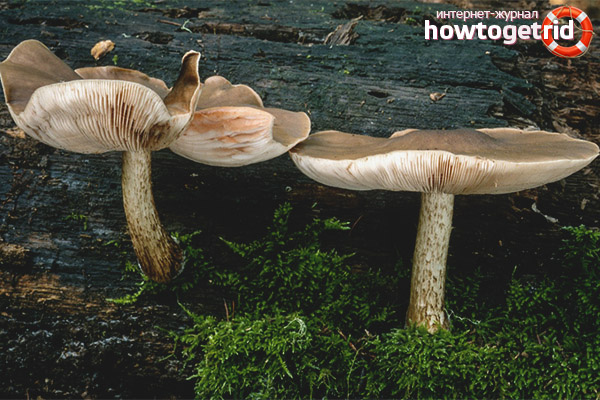The content of the article
A mushroom grows in the forest called deer whips. It looks unprepossessing, similar to an ordinary grebe. But only experienced mushroom pickers will pick and put it in a basket, knowing that at home you can enjoy the taste and get some benefit from eating the mushroom.
Description
The deer mushroom is a deer from the pluteev family, and has other names in the people: deer mushroom, dark-fibrous whip, brown whip. Deer is not called because the mushroom is so adored by deer (although they really eat it with pleasure), but because of its color - just the color of the coat of this northern animal. And also because the hymene ends in small growths similar to deer horns.
This agaric is edible, but some sources suggest that it is not necessary. At the same time, without giving a reason.
The fungus has a variable appearance, there are several options.
A hat. Very large, the diameter can be very small - 4 cm, and large - 15 cm, larger specimens are found - 25 cm. And it has a different shape - it can just be convex, in the form of a wide bell. It may be convex, but have a tubercle in the middle. And sometimes it is open. The skin is smooth, during the rain it becomes mucous. Fibers pass along the surface. Color varies from grayish-chocolate to dark brown, if there is a drought - colorless. The edges are lighter than in the middle.
Leg. Not very thick, 1.5-2 centimeters in diameter, cylindrical, the thickening goes to the base, it is easily separated from the cap. Depending on the place where it grows lute, it may be slightly curved. The color is light gray, closer to white, the darkish fibers located are clearly visible, you can sometimes notice a mesh pattern. The flesh is light white, the color does not change at the break, thick, fairly stiff, but easily breaks. It tastes quite pleasant, even something unusual.
Records. They are located freely, often, plump, wide, young pink and white mushrooms, older - brown-pink. The spores are oval, pink, smooth.
Spread
It grows almost throughout Europe and in most of Russia. Refers to saprophytes, therefore - grows on decaying, or already dead conifers and deciduous species. Suppose, on a pine or on a birch, it can grow on an oak tree. This mushroom can be found not only on trunks - it gladly settles on rotten stumps, rotten branches, it is quite capable of choosing a place for sawdust growth, an armful of deadwood, the old bark of a tree. It is found in forests of any type, grows in city parks, gardens, and is at the clearings. It grows directly on the ground, if there is a rotting stump nearby - it forms mycorrhiza with roots.
Fruits in late May to early September, in July-August - the largest crop. Even if there is no rain and the weather is dry, the whip will grow and multiply well.
Benefit

The whip contains many B vitamins, is rich in vitamins C and D, therefore it is quite capable of becoming a competitor to cereals and beef liver. These mushrooms have a lot of lecithin, which helps to reduce cholesterol and improve overall health and mood.
From mushrooms, a number of antibiotics, medical tinctures and other drugs are obtained. The substances included in the composition of the plutea help the breakdown of fats in the body, and the fiber contained in it helps to combat unnecessary kilograms and has a good effect on the digestive process.
Mushrooms can also boast of containing a large number of different minerals - there is iron, manganese, phosphorus, potassium, copper, iodine.
Culinary use
There is only one small nuance: it is best to eat young specimens, because adults (and especially older ones) have an unimportant sour-rancid taste that does not threaten health, but spoils the whole dish.
Some precautions
There is practically no harm from this fungus. He has a memorable appearance, it is quite difficult to confuse with toadstools. Poisonous inedible analogues are also not available. Only one danger can lie in wait for the mushroom picker - mushrooms growing along roads and near the city accumulate harmful substances. Therefore, having come home, it is better to put the collected prey for half an hour in salted water so that the accumulated toxins come out.
Video: deer deer (Pluteus cervinus)










Submit